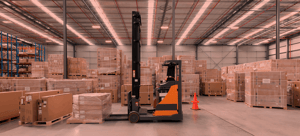Ensure a Smooth Implementation With These Three Tips From the Routeique Team
In our past blogs, we’ve highlighted the importance of choosing the right 3PL partner. This week, we share our implementation team’s tips on what to expect and how to make the most of the software and data you are gaining from your tech-enabled 3PL partner.
Key Takeaways:
-
Allocate resources to cleaning and correcting data to allow for seamlessness and accuracy.
- Monitor inventory levels, cycle times, and customer trends to stay proactive and operate efficiently.
- Be prepared for slightly more communication during implementation, but less need for meetings in the long run, as you’ll have everything at your fingertips.
Tip #1: Use Implementation As A Milestone To Kickstart Data Cleanup
“The best data you can provide upfront is going to provide value down the road.”
- Alan Surasky, Routeique Implementation Lead
Cleaning and organizing your data is essential to successful implementation and achieving insight, foresight, and oversight.
Allocate Time and Resources for Accuracy and Efficiency Down The Road
Our team frequently finds that data needs to be cleaned up before and during implementation. Alan, Implementation Lead at Routeique, highlights, “It is a task that no one likes to do, and may not immediately seen value-adding, but using [implementation as a motivator is important because the best data you can provide up front is going to provide value down the road.”
Additionally, because there is some data sharing that happens, depending on the level of integration, between your system and the tech-enabled 3pl, you may create twice as much clean-up down the road.
Consider A Deep Dive
According to Alan, it’s not just the obvious data that needs to be considered. For example, dimensional data concerning product size and weight might be considered ancillary within your own organization. However, if your 3PL has a bin packer or uses spatial optimization tools, that data is crucial for building boxes and pallets or allocating space. Dedicating resources to this can help ensure a smooth implementation.
Tip #2: Get The Most Out Of Your Data By Monitoring Key Metrics
Once your initial data has been cleaned and new data about your orders is flowing, you can stay ahead of the curve by monitoring some of the following key metrics.
Inventory Levels
Inventory levels should always be top of mind. A Forbes article in 2022 noted, “Improper inventory tracking is one of the major causes for lack of cash flow, weak profit, and stocking issues.” On the other hand, leveraging data can enable you to operate leaner and use strategies like Just In Case Inventory Management effectively.
A tech-enabled 3PL allows you to operate leaner by allowing you to ensure you have the right amount of product in the right places. For warehouses that are not tech-enabled, you might check in less frequently and send larger quantities of inventory – but a tech-enabled 3PL partner allows you to use data to carry less safety stock. Monitoring inventory levels and keeping an eye on cycle times enables you to replenish inventory at the appropriate rates and reap efficiency benefits while avoiding stockouts.
Customer Trends
“Companies have higher demand volatility, and history is a poor predictor of future demand,” according to a recent Forbes article.
Keeping an eye on customer trends can help you keep and retain clients. By doing this, Alan says, “you can reach out when you start seeing the first signs of a problem vs later hearing that they moved on 6 months after the fact.”
For example, let’s say your tech-enabled 3PL’s software suggests customer X normally orders product Y on a certain frequency, and you notice they have been trending down or up or missed an order. Once you are aware of this, you can proactively reach out to that customer to see what is going on – is the product still moving? Are they considering a different supplier?
This allows you to keep business that might otherwise have been lost and even build a stronger customer relationship.
Tip #3: Don’t Forget Communication
“Moving objects from one location to another requires a lot of planning, organization, and communication.”
- TechGuide, 2023
At first, you can anticipate more frequent touchpoints and updates, which is important to account for.
However, as everyone adapts to the new process and things are flowing, products are moving, and reporting is working, the touchpoints can become less frequent because you don’t need to monitor them.
At this point, you can spend time adding value to your operation by finding new clients and opportunities and enhancing customer service.
Want to Learn More?
Want to learn more about working with a 3PL or 4PL partner? Browse our past blogs, and follow us on LinkedIn to catch the next two blogs in this series!




